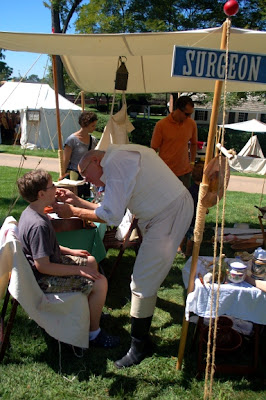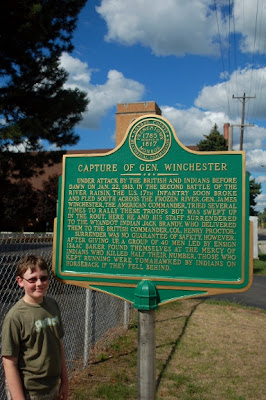Inside the rotunda of the George Rogers Clark memorial.
While driving the backroads in Indiana, I spied a historical marker than made me come to a stop . . . the burial place of Jane Todd Crawford! Above, to the chagrin of Dudeboy, Dr. J is portraying the pain Crawford must have experienced when Ephraim McDowell performed the world's first ovariotomy in Danville, Ky. The removed tumor weighed a total of 22 1/2 pounds! And this was done without the use of any anesthesia. Dudeboy and I visited the McDowell house a few years ago.
The Home of Eugene V. Debs in Terre Haute, In. Unfortunately, it was closed. The marker states:
Debs (1855-1926) was leading pioneer in industrial unionism, social reformer, and peace advocate. Founded American Railway Union, 1893; cofounded American Socialist Party, 1900; and ran five times for United States presidency. Home built in 1890; declared National Historic Landmark, 1966.
Mecca Covered Bridge, located near Mecca, Parke County, In . . . 1873.
Parke County, In. proclaims itself to be the "Covered Bridge Capital of the World." There are 31 covered bridges located in the county.
Sim Smith Covered Bridge, located near Montezuma, Parke County, In . . . 1883.
Phillips Covered Bridge, located near Montezuma, Parke County, In . . . 1909.
The Narrows Covered Bridge, located in Turkey Run State Park, Parke County, In. . . . 1882.
The suspension bridge that crosses Sugar Creek in Turkey Run State Park.
Rocky Hollow Canyon in Turkey Run State Park.
The Cox Ford Covered Bridge located on the western edge of Turkey Run State Park, Parke County, In. . . . 1913.
The Wilkins Mill Covered Bridge located near Rockville, Parke County, In. . . . 1906.
Historic Prophetstown (located in Prophetstown State Park and near the original site of Tecumseh's village) represents a working 1920's farm. Our favorite attraction was the replica Sears Roebuck and Company catalog farmhouse.
Miami Indian Cemetery near the Mississinewa Battlefield. A nearby historical marker states that this is:
The largest Indian cemetery in Indiana. Few graves are marked. The Indians buried here are largely descendants of Chief Metocinya and include Meshingomesia and his family. The first burial was probably in 1873. Burial was contrary to Indian tradition and reflects Christian influence. An Indian Baptist Church and an Indian school were located here. Otto Winger taught at the school 1895-1898. This land is part of the last Indian reservation in Indiana. The site of the battle of Mississinewa (1812) may be seen along the Mississinewa River to the southwest.
Statue of Edith Hamilton at the Headwaters Park in Fort Wayne, In.
Fallen Timbers Battlefield, Maumee, Ohio.
Turkey Foot Rock . . .
On this rock according to tradition, Chief Turkey Foot of the Ottawa Indians rallied his warriors during the Battle of Fallen Timbers. Here he was killed and for many years tribesmen made offerings of tobacco on the rock to appease the Great Spirit.And on the monument in the back . . . "In memory of all the American Indians who gave their lives at this place, including members of the following tribes: Chippewa, Ottawa, Delaware, Potawatami, Miami, Shawnee, Mingo, Wyandot"
The Fallen Timbers Battlefield Monument . . .
To General Anthony Wayne who organized the “Legion of the United States” by order of President Washington and defeated Chief Little Turtle’s warriors here at Fallen Timbers August 20, 1794. This victory led to the Treaty of Greenville, August 3, 1795. Which opened much of the present state of Ohio to white settlers.Elsewhere on the same monument it also states, "In memory of the white settlers massacred 1783-1794." And on the back it states, "To Chief Little Turtle and his brave Indian warriors."
Lake Erie at Maumee Bay State Park . . . our home away from home for most of the trip.




















































